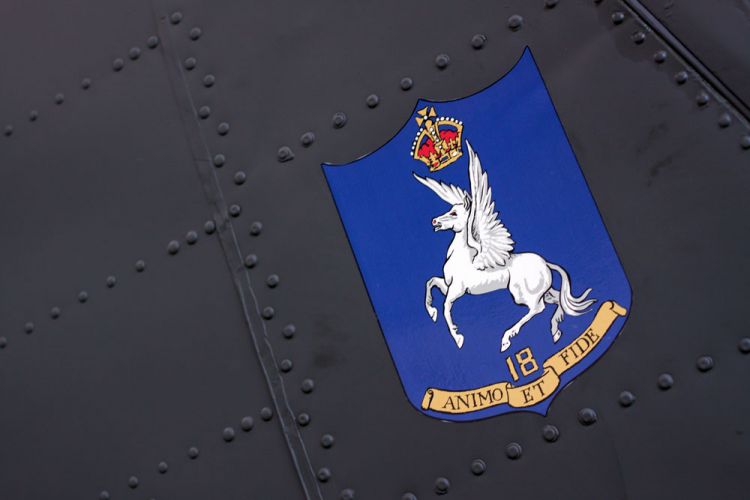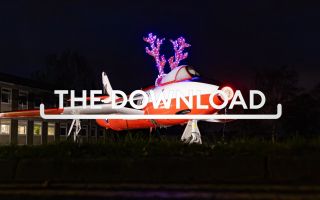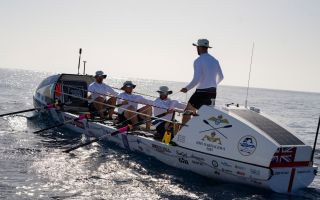Squadron Celebrates 100 Years Of Service
Established in 1915 by the Royal Flying Corps at Northolt airfield, 18(B) Squadron has changed considerably over the last 100 years.
To mark 18 Squadron's centenary, a small team at RAF Odiham were tasked with researching the Squadron's history and designing a special anniversary scheme Chinook.
Last week Tom Mercer was lucky enough to get a sneak peak at ZA712 and shared his photographs and experiences from the day with Forces.tv..
At first, the scheme looks incredibly impressive but when you start to look at it in more detail, you quickly realise just how much time and effort has gone into it.
The decision had been made to include the original Squadron badge on the aircraft right from the very beginning but this soon led to a much bigger idea; was it possible to design a scheme that encapsulated the transition from 1915 right up to 2015? The concept was to show the transition from the white wings of the early Pegasus, to the red wings of the modern day Pegasus.
Flt Lt Andy Donovan, a Pilot on 18(B) Squadron's OCF, was on hand to talk us through the scheme:
"We'll start at the very beginning of our existence; the crest on the side here - the white Pegasus and the blue shield - is the crest that the Squadron started with back in 1915. In 1918 we became a Royal Air Force unit and it took until 1936 for the RAF to standardise Squadron badges. The change from white to red was made by the Commanding Officer in 1936."
"The white banding at the front of the aircraft is to recognise the wings of Pegasus and ‘Animo Et Fide’ is the squadron motto; this translates to ‘With courage and faith’."
"Moving back towards the tail end of the aircraft, you've got these various different bands and lines, they signify the various changing roles of the Squadron in the modern age. Now that my colleagues on the Squadron have returned from Afghanistan this is even more true and the Chinook Force as a whole is starting to diversify it’s training again so that it's ready for any eventuality in the world."
"The white behind the fourth window along signifies the maritime role that we're involved in as well, the wave demonstrates our commitment to exercises like Joint Warrior aboard HMS Ocean."
"Down to the rear section and it shows the 1950s Canberra era when we were part of the Scampton wing but based at RAF Upwood. The Canberras usually carried a speedbird graphic on their nose, blue or black depending on where you read about it, but we've applied a bit of artistic license in making it red to coincide with the rest of the scheme."
"On the front, above the cockpit, you can see a poppy graphic and a white 'W'. Prior to going into the paint shot, the aircraft was coded AT but we decided that the W was more relevant for this scheme because we are one of a few squadrons to have a Victoria Cross winner in our history, with Wing Commander Hugh Gordon Malcom. He was well known for leading extremely dangerous raids in his time and in December 1942 he was airborne on a mission to attack an enemy airfield to make sure that assets on the ground couldn't be used to attack an offensive that was going on in the area by Allied Forces.
During that raid, the entire Squadron was shot down alongside him which makes this a very significant event in our history; the 'W' recognises his Blenheim which carried a 'W' on the tail. The red poppy sadly recognises each and every life lost in the last 100 years of 18 Squadron. We must never forget the sacrifices made by those who have come before us and at this time of celebration it was highly important to make them part of this moment"
To say that a lot of time and effort has gone into the design of this scheme would be a massive understatement. The sheer scale of the design has to be applauded.
"We've gone about as far as we possibly could with it, bearing in mind the limitations that were put on us. Looking back, the only time that a scheme has been done on this scale on a Chinook was in 1989/1990 for the 7 Squadron 75th anniversary. Amazingly there was no meaningful record of past schemes from an engineering perspective, the last accurate record we have is of the Gulf War scheme from 1991."
Interestingly enough, ZA712 was actually one of the Gulf War schemed aircraft all the way back in 1990.
What makes this commemorative scheme even more impressive is that it was designed solely by active members of 18 Squadron and as Flt Lt Donovan explains, at times, the project progressed with as little as two or three people on board:
"It’s taken a huge percentage of the Squadron’s involvement, plus the very talented and committed engineers and paint specialists at Odiham to get this researched, designed and delivered on time.”
"The aircraft took roughly three weeks to paint from start to finish. The level of detail is unprecedented, you'll find areas all over the fuselage with a number of different colours on just one rivet. This particular airframe had only recently returned from theatre so was completely sand-blasted. The whole fuselage was stripped, painted green and then had the special scheme applied."
When compared to other Air Forces around the world, I think it's fair to say that RAF special schemes have been somewhat lacking in recent years but 2015 seems to be a year of brilliantly designed specials. I've often wondered how it feels to be gifted the privilege of delivering and flying a one-off airframe; Flt Lt Donovan summed it up perfectly:
"It’s incredibly surreal. Juggling a lot of things for the past six months has been very tricky but seeing the finished aircraft here, I feel extremely proud. To stand here and see it in the flesh is surreal. It’s been fairly difficult keeping the design a secret. We started with chalk markings on the aircraft in February, so it’s been a long time coming. Obviously it’s something that happens in the fast jet fleets quite often but on rotary aircraft, it’s almost unheard of."
The good news is that there will be plenty of time to see ZA712 out and about in this scheme as it won't be removed until the aircraft enters deep maintenance in the early part of 2016. Although the 2015 Chinook Display is flown by 27 Squadron, I wouldn't be surprised if you see the 18 Squadron airframe appear at a number of events up and down the country, after all, why wouldn't you want to show it off to the world?











